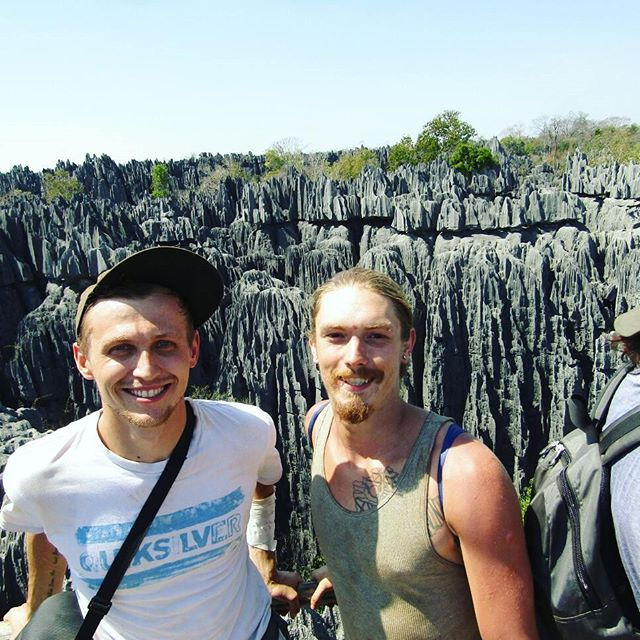The Tsiribhina River, Tsingy National Park and the Avenue of the Baobabs
- Angus Rees
- Sep 6, 2017
- 4 min read
Day 1 – Antsirabe to Miandrivazo
The 4-5-hour journey from Antsirabe will take you through the highlands of Western Madagascar until you reach Miandrivazo, a small town which is the start point for many tours on the Tsiribihina. The drive itself is uneventful with only two stops on the way: once for lunch and another for a small waterfall that in our books perhaps did not merit a stop.
Days 2 and 3 – Canoeing the Tsiribihina
The river journey begins on a tributary to the Tsiribhina. After a few hours, you join the Tsiribihina and the landscape is simply stunning. As you meander down the river you could be forgiven for thinking you were on a different planet, the red mountains combined with sheer desolate landscape makes you feel like you are on Mars. It takes the sightings of lemurs, birds, crocodiles and a handful of scattered huts to bring you back to reality.

At night, you camp on the river banks and with no light pollution the milky way is clearly visible in the night sky and we happened to be there during a full moon which was simply stunning.

You will spend around 8-10 hours of the day on the boat with no shade whatsoever and little room for movement so it is important to bring your sunscreen and an enjoyable book to read. On the last night, the local villagers organize some music and dancing which you can take part. If you aren’t the one to normally dance, some Tocagasy (local home-made rum) may help with that.
Day 4 – Zebu Carts + 4WD to Beramaha
The morning of the fourth day will see you load your gear onto Zebu Carts which are carts drawn by Zebu (equivalent of bulls) and travel 13 kilometres through villages on dirt tracks and across rivers. Our driver had a sense of humour (or was lazy) and let us take the reins for some of the journey which was a hilarious and fun experience not only for us but for the locals who weren’t used to seeing Vaza (white people) man the carts.


Once off the carts, the kit was packed onto the roof of a 4x4 and the long drive to Bekopaka, on the edge of Tsingy National Park, began. We stopped in Belo-sur-Tsiribihina for lunch and took a couple of car ferries (two boats welded together with a wooden flooring) before arriving there in the evening where we set up camp.
Day 5 – Big Tsingy and Small Tsingy
The fifth day begins with breakfast around 6:00 AM after which you proceed to Big Tsingy in the Tsingy de Bemaraha national park by 4x4. Big Tsingy is the world’s largest stone forest at around 230-square miles. The hike through the razor sharp limestone formations is not only beautiful but also quite adventurous at times. Beginning with a 20 minute walk through the forest you quickly progress to some via ferrata where you attach yourself to a harness and begin the final ascent to reach the top. This is the most fun bit (unless you’re scared of heights). The climb is well worth it though as the views from the top are simply stunning and it is here that you can take some breathtaking photos.

After spending half an hour on the summit you begin your descent back into the forest where the guides will point out groups of lemurs and chameleons if you are lucky. We managed to see quite a few lemurs lazing around the tree canopy.

After finishing Big Tsingy you return to the campsite for lunch and then quickly head to Small Tsingy. After having seen Big Tsingy this smaller brother of a stone forest doesn’t seem quite as impressive. The tour takes around 45 minutes, beginning with a small “museum” and reaching some viewpoints that all seemed underwhelming compared to the morning stint.
Day 6 – Alle de Baobab and Morondava
On the final day you’ll spend most of your day in the 4x4 as the journey to Morondava takes roughly 8 hours. Two car ferries are used, and on one journey we had seen another ferry had sunk at the port we were trying to get off at, a rice truck had failed to get up the hill and then stalled rolling back into the other ferry and sinking 3 4x4s, one of which had toursits aboard. Thankfully nobody was hurt in the accident.
Just before Morondava you’ll be taken to see a series of Boabab trees such as the Sacred Baobab and the Lover’s Baobab which make for okay photos and are quite interesting. However, the final stop before Morondava, the Avenue of the Baobabs, is by far the most impressive and it is here that you will stop to watch the sunset behind the famous stretch. Aside from the hundreds of other tourists getting the same shot as you it is a sunset we’ll never forget.

You can have a beer while you wait or explore the many small stalls selling arts and crafts. After sunset you make your way to Morondava where the tour ends. (If you haven’t booked accommodation for the night like us, you can always ask to be dropped off near Chez Jean where there are a few hotels/hostels nearby at a good price).









Comments